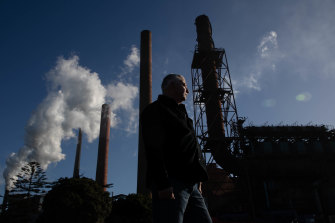For South Coast Labour Council secretary Arthur Rorris, intensifying debate over what a low-carbon future may mean for Australia’s industrial centres is a signal the rest of the country may finally have caught up with the Illawarra.

‘It’s going to be massive’ if the steelworks were to close: Arthur Rorris, co-convener of Recharge Illawarra, at Bluescope’s facilities at Port Kembla.CREDIT:JANIE BARRETT
“That’s whether we are going to share in the jobs created by the coming revolution, ” he says. “Or will we stand on the sidelines and watch the rest of the world take them?”
Often left out of discussions about a so-called transition off fossil fuels, the area around Wollongong hosts the nation’s largest steelworks, fed by coal mined in a hinterland that also includes several dams serving greater Sydney.
Boasting a deepwater port and heavy industry with two centuries of heritage, the Illawarra rivals the NSW Hunter and Victoria’s Latrobe Valley as a region with the most at stake – and perhaps most to gain – if Australia can do its share of the decarbonisation needed to curb global heating. So far, there is no national effort to steer such a shift.
Read the full article published in the Sydney Morning Herald 28th September 2021